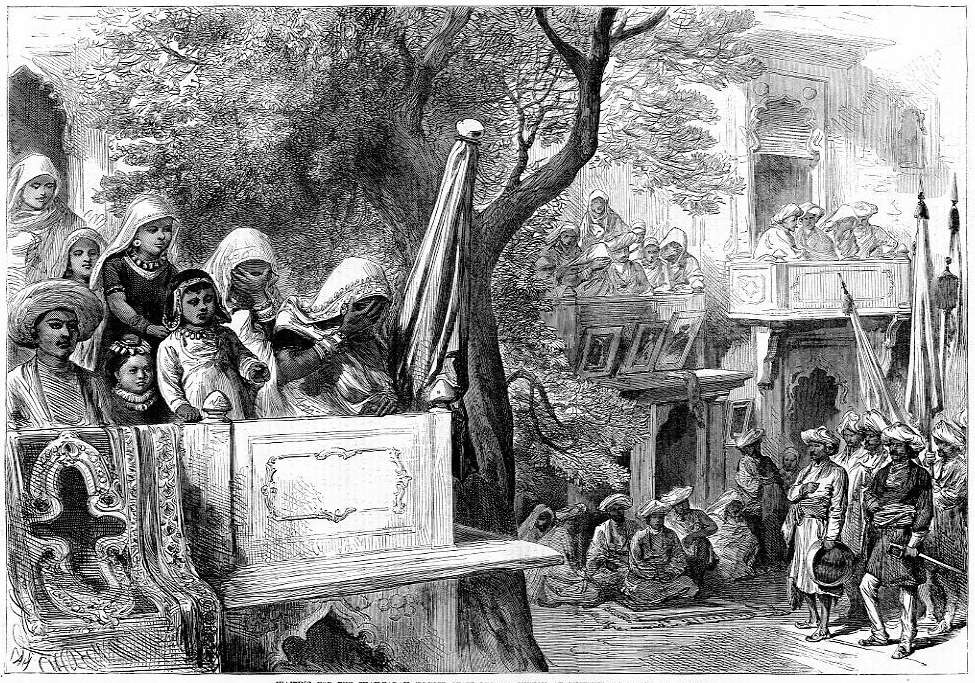
*For comparison: street life in Smyrna (modern Izmir), Turkey, in the 1840's*
Source: ebay, Aug. 2005
"Steel Engraving from 1840: A Street in Smyrna - Turkey. Artist: Allom; Engraver: Higham. Published by Fisher, Son & Co., London & Paris."

"The Royal Visit to India: Waiting for the Shahzadah, Gwalior," from the Illustrated London News, 1876; *a much larger scan of this engraving*
Source: ebay, Sept. 2006
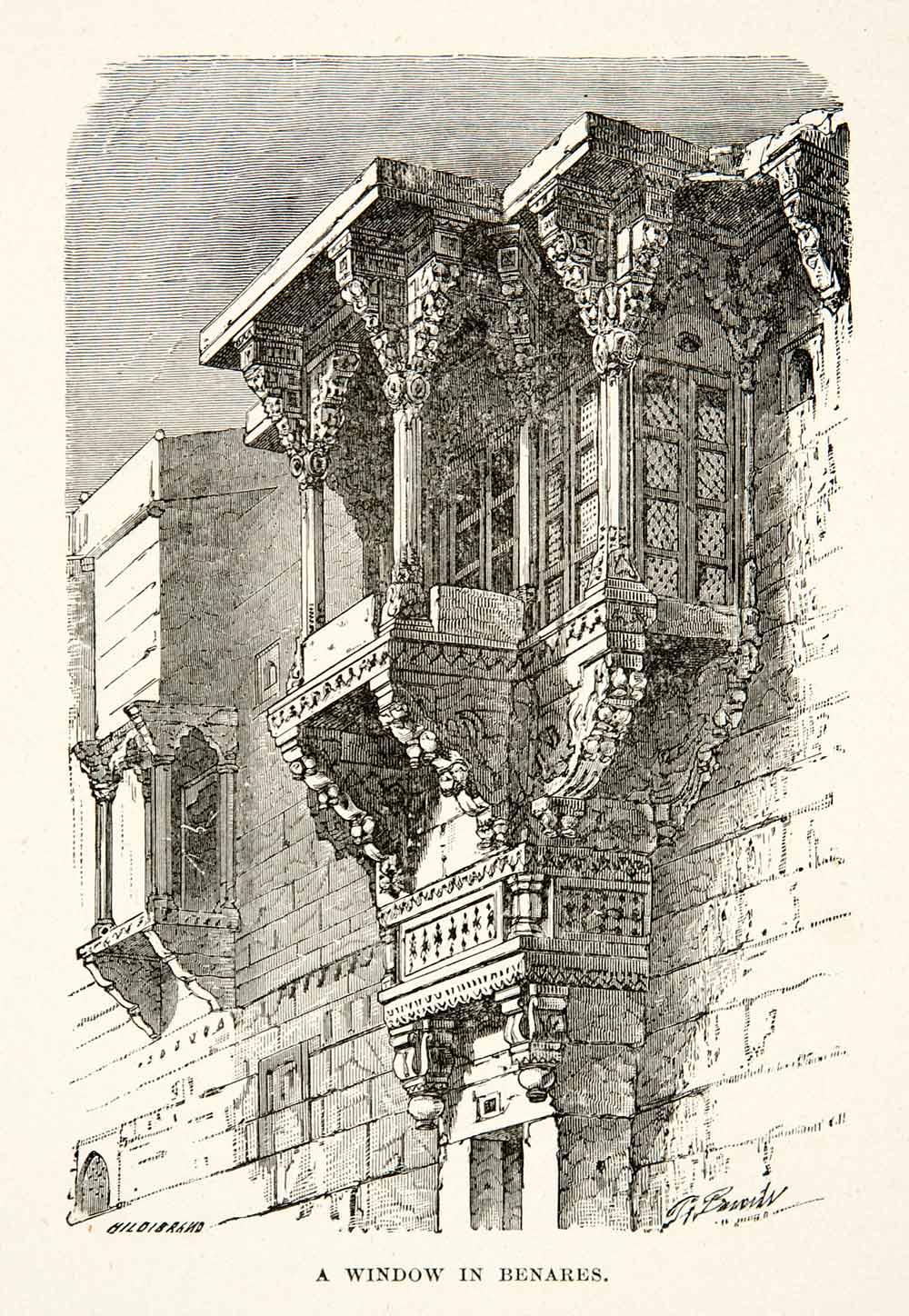
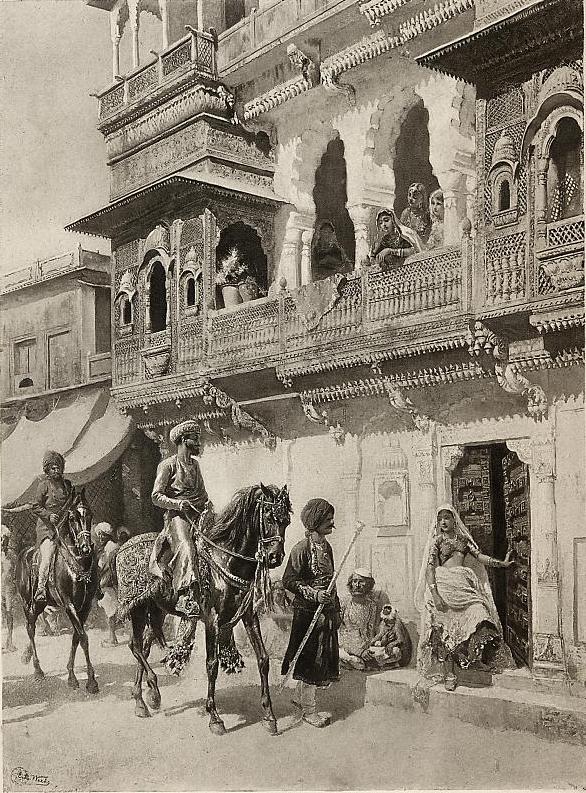
"Promenade of the Rajah," 1880's, a photogravure of a painting by Edwin Lord Weeks
Source: ebay, July 2001
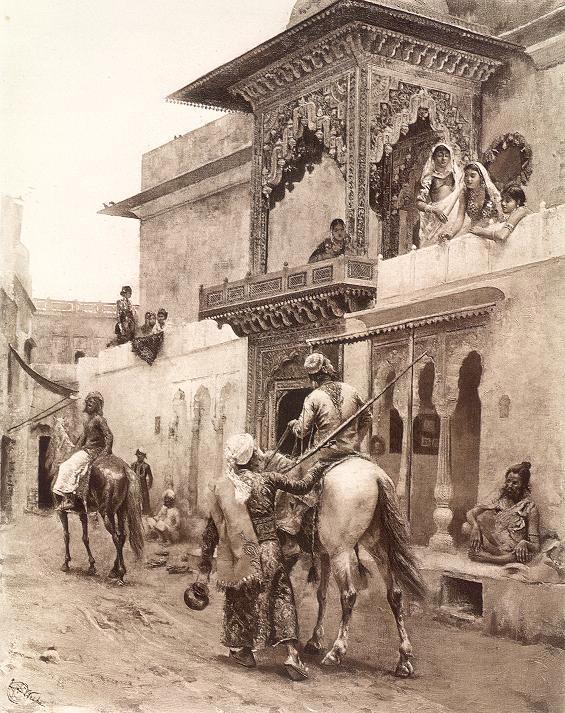
"Cashmere Travellers in a Street of Delhi," 1880's, a photogravure of a painting by Edwin Lord Weeks
Source: ebay, Mar. 2002
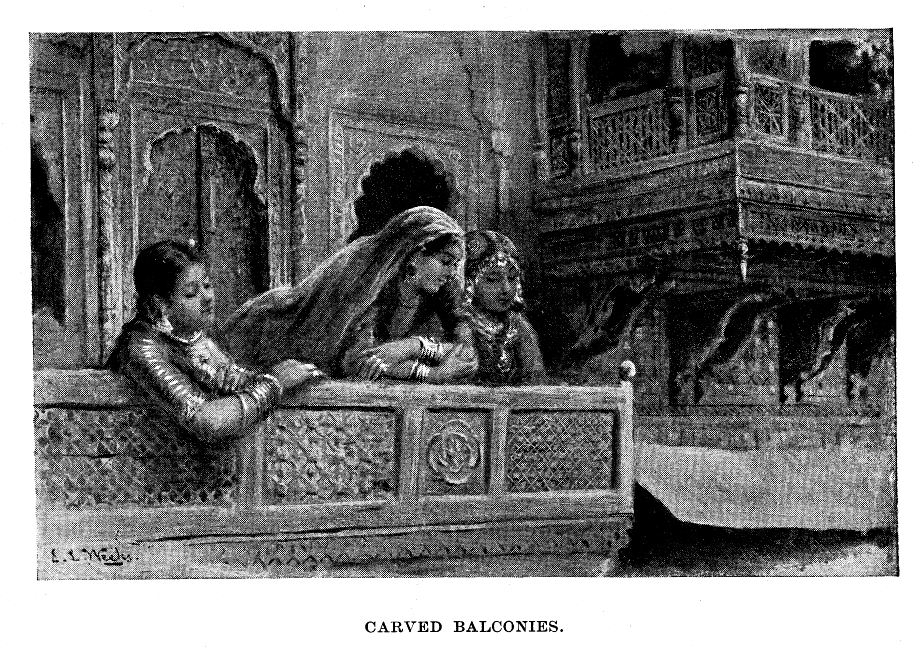
Women on a balcony, Lahore c.1894, by Edwin Lord Weeks
Source:
http://cdl.library.cornell.edu/cgi-bin/moa/pageviewer?frames=1&cite=http%3A%2F%2Fcdl.library.cornell.edu%2Fcgi-bin%2Fmoa%2Fmoa-cgi%3Fnotisid%3DABK4014-0089-72&coll=moa&view=50&root=%2Fmoa%2Fharp%2Fharp0089%2F&tif=00672.TIF&pagenum=650
(downloaded March 2001)
From "Lahore and the Punjab," by Edwin Lord Weeks. Harper's
New
Monthly
Magazine 89,33 (June-Nov. 1894), pp. 650-672. From the
Cornell Univ. Library website. This illustration is on p. 662.
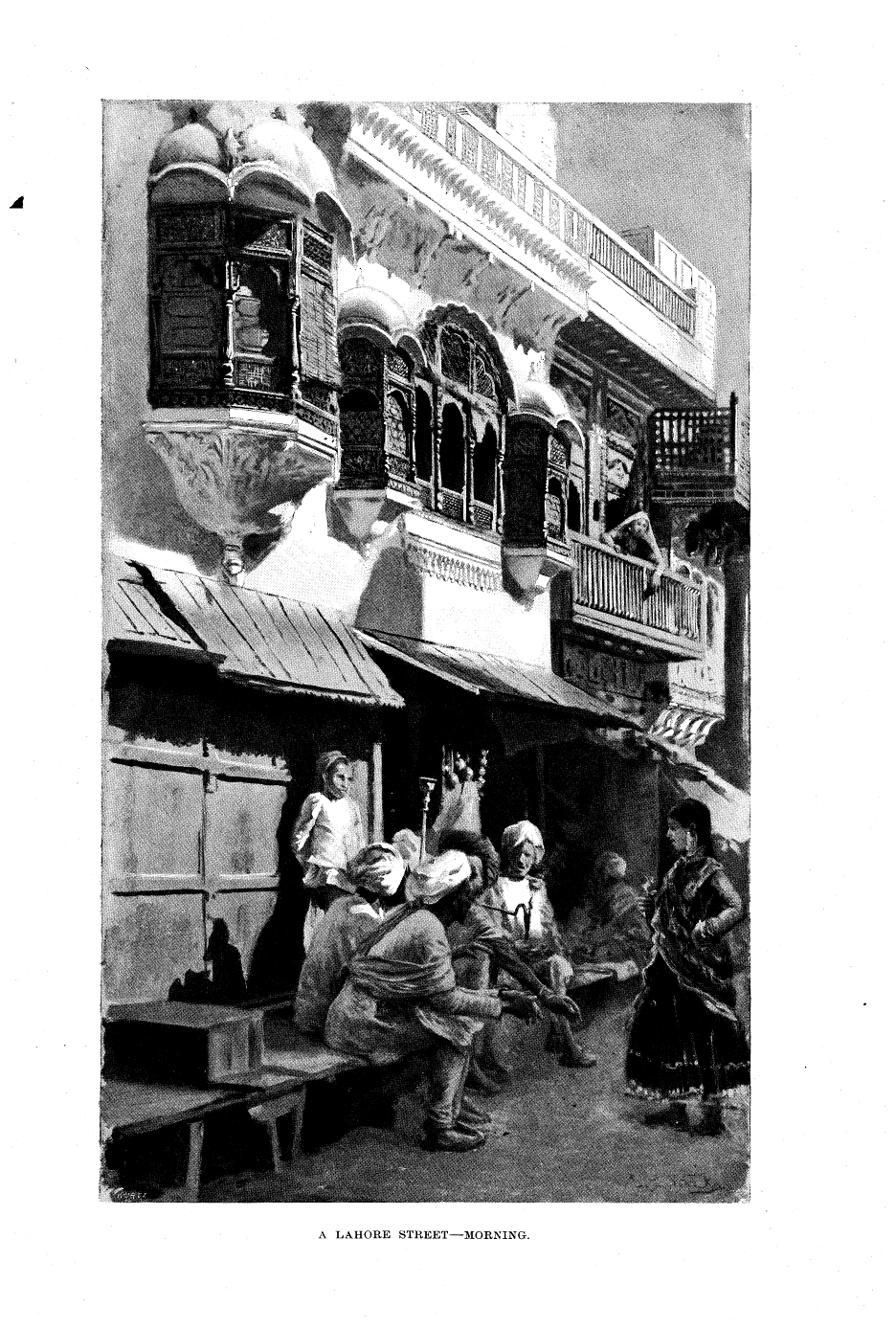
source:
http://cdl.library.cornell.edu/cgi-bin/moa/pageviewer?frames=1&cite=http%3A%2F%2Fcdl.library.cornell.edu%2Fcgi-bin%2Fmoa%2Fmoa-cgi%3Fnotisid%3DABK4014-0089-72&coll=moa&view=50&root=%2Fmoa%2Fharp%2Fharp0089%2F&tif=00672.TIF&pagenum=650
(downloaded March 2001)
From "Lahore and the Punjab," by Edwin Lord Weeks. Harper's
New
Monthly
Magazine 89,33 (June-Nov. 1894), pp. 650-672. From the
Cornell Univ. Library website. This illustration is on p. 659.
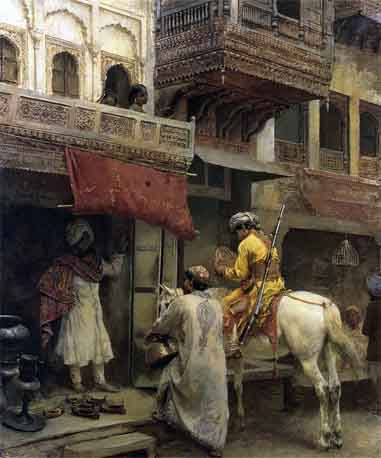
Another street and balcony scene by Weeks, with the original color
Source: ebay, Apr. 2006
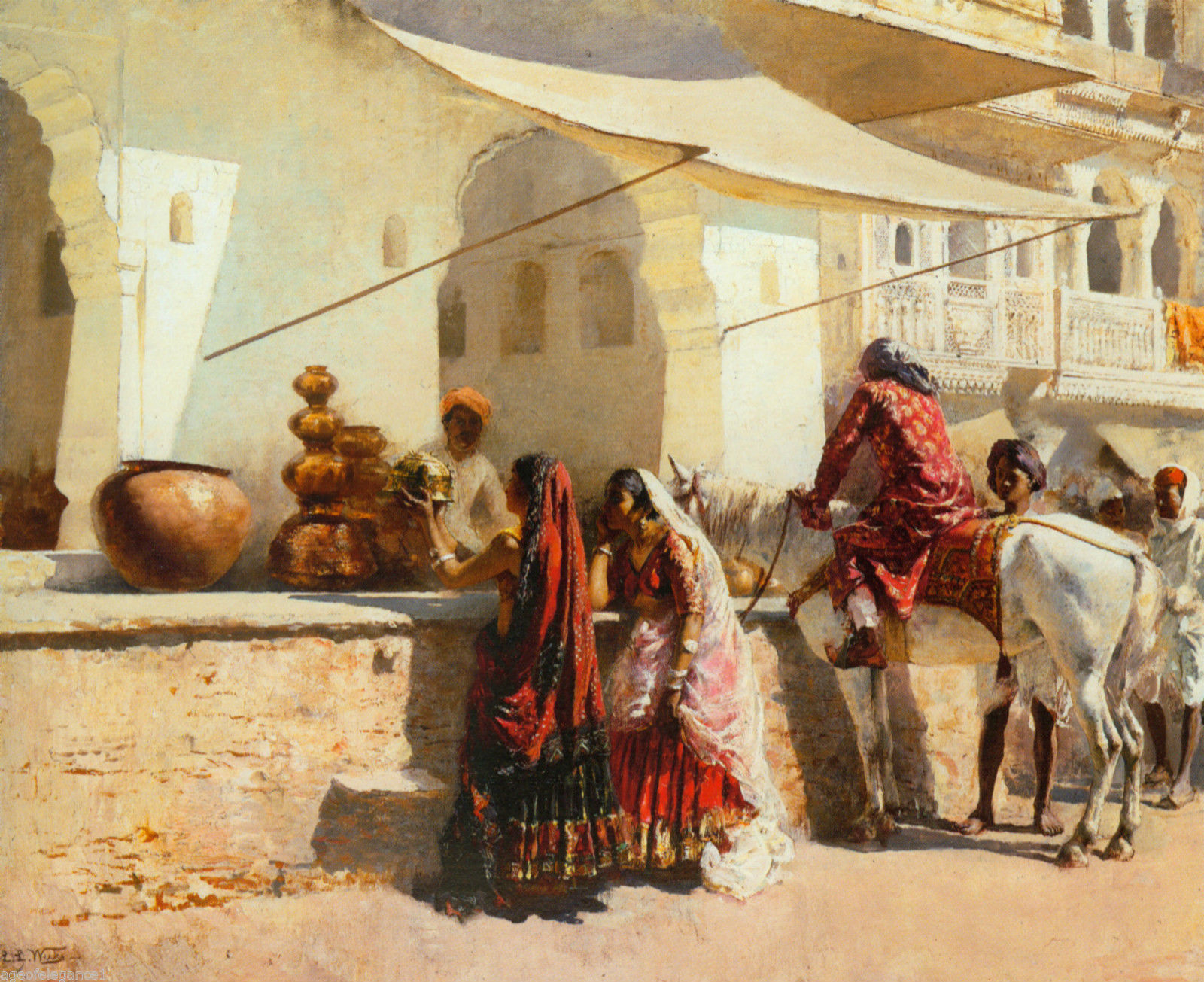
Another Rajasthani street scene by Edwin Lord Weeks, 1887, probably in Udaipur
Source:
http://www.christies.com/LotFinder/search/LotDetail.asp?sid=&highlights=%3Cspan+class%3D%27esn%5Fsegment%27+title%3D%27%2FLotCommon%2FCatalogueEntry%27%3E%0AA+Street+Market+Scene%2C+%3Cb%3E%3Cspan+class%3D%27esn%5Fhighlight%27%3EIndia%3C%2Fspan%3E%3C%2Fb%3E+%26lt%3BBR%3C%2Fspan%3E+%2E%2E%2E&intObjectID=4800778&AllObjectIDs=4803582,4803587,4801548,4802265,4793188,4800859,4800778,4799488,4799822,4801547,4801555,4801581,4801553,4801340,4801558,4801556,4801554,4801482,4801559,4801557&RefineQueryURL=AdvancedSearch%2Easp%3Fsid%3D%26entry%3Dindia%26T%3DLot%26P%3D%26CF%3D%26SU%3D1%26RQ%3DFalse%26AN%3D1
(downloaded Oct. 2006)
"Edwin Lord Weeks (American, 1849-1903). A Street Market Scene, India; signed 'E. L. Weeks' and stamped with his Mogul device (lower left); oil on canvas. 23¾ x 29 in. (60.5 x 74 cm.). Painted circa 1887
Lot Notes: A Street Market Scene, India is a fine example of Edwin Lord Week's quotidian street scenes of northern India. In these paintings, Weeks demonstrated his great skills in draftsmanship, color and texture in his precise yet suggestive visual records of his Indian travels-the very ordinariness of the scene contrasting sharply with the beautiful forms, rich colors and textures of the elements and actors depicted. The scene is entirely characteristic of north Indian city streets, in which the street is the promenade and a row of shops occupy a built-up platform beneath an arcade of windows and bracketed balconies. In the present work, the city depicted is probably Udaipur (then Oudeypore) as suggested by the elaborate windows and shallow balconies, depicted at the right side of the painting, and by the white plaster covering thebuilding walls. In his travel journal from the Black Sea through Persia and India Weeks wrote of Udaipur as 'an endless expanse of white.'
The painting was executed circa 1887 in two stages. Initially, the architectural backdrop of the picture would have been painted in situ; a plein air rendering of the physical context. The second stage of the painting would have been executed either while still in India or, more likely, some time later in the artist's studio in Paris. In this second 'campaign', the figures and animals would have been added to the painting, based upon a multitude of such elements and poses Weeks had executed in India. The present painting is highly finished, suggesting it was completed in Week's Paris studio. a metalsmith's shop in the shadowed background of white walls and delicately fashioned arched openings. The whitewashed setting serves as an an almost neutral background off which the artist plays with great still-life of dancing color and reflections - from a large copper pot, to copper and brass jugs and bowls, stacked on high. The pot in the woman's hands brilliantly reflects the sunlight in its brassy colors and reflections. The figures, too, are brilliantly rendered, with variegated silk and cotton embroidered costumes, and flowing translucent white muslin. The women's arms are covered in silver bracelets, their ears in long silver earrings and their necks in goldnecklaces - all of which suggests they may be nautch dancers from the Court. The women's bare midriffs, unusual in more southern parts of India, caught Weeks' attention at the time.
'In all the north country costumes there is a wide gap between the bodice and the skirts and the wearer never seems anxious to conceal it' (Weeks' letter to the president of the Pennsylvania Academy of Fine Art, September 18, 1883). The painting relates to, and very favorably compares to, other Weeks paintings of this genre, including A Street Scene in the East (National Collection of Fine Arts, Smithsonian Institution), The Soldier of the Rajah Coming to the Sword Sharpener of Ahmedabad (Portland Museum of Art), and A Street Scene in North West India, probably Udaipur (sold at Christie's London, 24 September 2003, lot 86). This last work shows a Rajput in blue silk on a similar horse, and two young women dressed exactly like the two women in the present painting, though rendered in shade instead of the brilliant light of the present work. A favorite device in many of these paintings is a Rajput noble atop or standing next to his elaborately-saddled horse, turned towards the shop fronts engaged in studying items for sale or, often, seen in flirtations with young women dressed in a manner similar to the figures in the present painting, all with comely faces or profiles.
We are grateful to D. Ellen K. Morris for providing the catalogue entry for this work. This painting will be included in the catalogue raisonné being prepared by Dr. Ellen K. Morris."
== Indian Routes index == Indian Routes sitemap == Glossary == FWP's main page ==